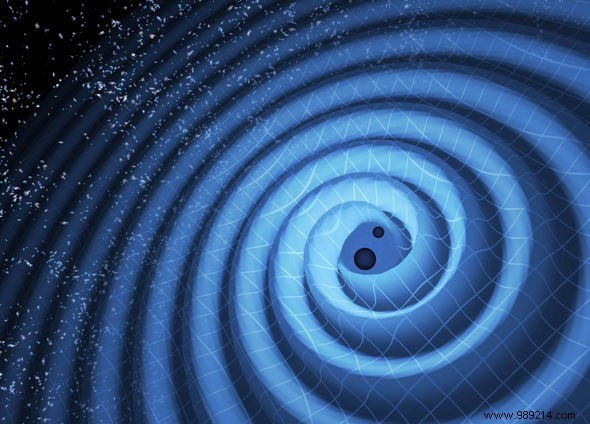A team of astronomers announces they have observed thirty-five new bursts of gravitational waves, tiny ripples in the fabric of spacetime. On this sample, one of them is still questioning the specialists.
Gravitational waves are generated when two very massive black holes approach each other in space. These ripples will travel through space at the speed of light and eventually reach our planet, compressing and stretching in alternating series everything they touch.
To detect these fluctuations, observatories use a laser beam. The latter passes through a semi-reflecting mirror to be divided into two. These two rays then bounce off two other mirrors which send them back to a detector. If gravitational waves pass, these two rays will then fluctuate successively and end up out of phase when they hit the final detector.
There are currently three main gravitational wave detectors in the world:the two LIGO facilities in the United States (in Louisiana and Washington State) and VIRGO in Italy .
Until recently, researchers had detected fifty-five such events. However, during the second half of the third observation period of these observatories, between November 2019 and March 2020, astronomers were able to detect thirty-five additional events , thirty-three of which involved two black holes each time. This brings the total number of detections to date to 90.
These thirty-five new events span the entire mass range of gravitational waves detected so far. In other words, that means objects of all shapes and sizes were involved in these collisions. Among them were neutron stars barely heavier than our Sun , but whose mass was compressed into a sphere the size of a large city , like black holes one hundred times heavier than our star .
“Only now are we beginning to appreciate the wonderful diversity of black holes and neutron stars. Our latest results prove that they are available in many sizes and combinations “, emphasizes Christopher Berry, member of the LIGO scientific collaboration. "We've solved some long-standing mysteries, but we've also uncovered some new puzzles “.

Indeed, one of these "new events" (most occurred billions of years ago) involving a twenty-four solar mass black hole questions always astronomers. According to analyses, its "tango partner" could be a black hole of 2.8 solar masses, but the hypothesis of a very heavy neutron star cannot be excluded.
“Each new release of observation bursts brings new discoveries and surprises. Future campaigns will likely find even more unusual events “, underlines Hannah Middleton, of the university of Melbourne. Indeed, the science of gravitational waves, which emerged in 2015 following the first detection, is only in its infancy.
Recall that the LIGO and Virgo observatories are currently undergoing some upgrades in preparation for their fourth observation campaign. The trio will soon be joined by the KAGRA observatory in Japan. All four should be operational by the end of next year.